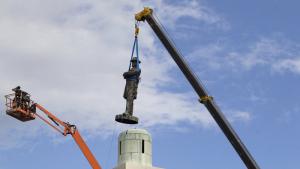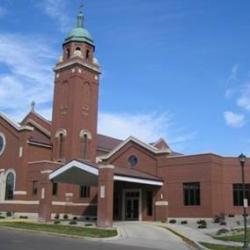

Destroying two statues, of Saddam Hussein and of a Confederate general: morally the same or different?
“The study of history has absolutely no use whatsoever.” That’s what a museum guide told me once. (I can’t remember the guide’s name or the museum’s.) It’s a sentiment that, I guess, most people would disagree with. Why else would people argue about Confederate s statues and memorial days like Columbus Day?
What brings this thought to mind is a friend’s comment about my post of last Friday, October 12. In it I praised the citizens of Mankato, Minnesota, for changing Columbus Day to Indigenous Peoples Day. My friend made me understand, helpfully, that the position I took was a bit controversial.
Not everyone agrees that changing Columbus Day is a good idea. Neither do we all agree about keeping or removing statues of Confederate heroes from public places. Isn’t the removal side saying, “Let’s just forget certain parts of American history”?
Different statues, different moral discernments?
The two pictures above show the removal of two statues. One is of Saddam Hussein, hated Iraqi ruler. The other is of a general in the Confederate army. Almost every American cheered the first action, but many question the second. Is the moral calculus of these two actions really all that different?
To me it seems exactly the same except that the Confederacy is quite a bit farther away in history than Saddam Hussein. Confederate statues themselves, though, are not as old as one might think.
The number of Confederate memorial installations peaked around 1910 — 50 years after the end of the Civil War and at the height of Jim Crow, an era defined by segregation and disenfranchisement laws against black Americans. Confederate installations spiked again in the 1950s and 1960s, during the Civil Rights Movement. (Business Insider article, “There are hundreds of Confederate monuments across the US – here’s when they were built”)
The purpose of these statues was less to honor a confederate ideal and Southern pride than to push back against Reconstruction first and the civil rights movement later.
The American Historical Society comments in “AHA Statement on Confederate Monuments” (August 2017):
Memorials to the Confederacy were intended, in part, to obscure the terrorism required to overthrow Reconstruction, and to intimidate African Americans politically and isolate them from the mainstream of public life. A reprise of commemoration during the mid-20th century coincided with the Civil Rights Movement and included a wave of renaming and the popularization of the Confederate flag as a political symbol. Events in Charlottesville and elsewhere indicate that these symbols of white supremacy are still being invoked for similar purposes.
Remembering history
People who object to removing statues and changing memorial days argue that to do so is to forget parts of American history. But when you think only of whatever good a Confederate statue might represent, you ignore more history than you remember.
Still one must remember history. Perhaps, as my friend believes, we should keep Columbus Day, keep the statues, but make special efforts to tell history correctly. We would teach clearly the harms native peoples and peoples of color suffered throughout most of American history. The point, though, is that these memorials themselves are ways of remembering history wrong.
Take statues, say, a statue of a Confederate general riding a horse. That statue does not honor the horse; it honors the man on the horse. It doesn’t honor the man for being a good person. He may well have been that to his family and his community and in his own conscience. But it honors what the man did on the horse. He carried on a war to perpetuate the institution of slavery. The statue does not remember history correctly.
Likewise, we remember Columbus on Columbus Day for the history that he started in these lands. For native peoples it was a history of cruel oppression. We must remember it, of course, but not celebrate it. A family celebration is not a good celebration unless it’s for every member of the family. Columbus Day is not a joyful occasion for Native Americans. Neither can a descendant of slaves feel good about a memorial to the Confederacy.
To remove such monuments is neither to “change” history nor “erase” it. What changes with such removals is what American communities decide is worthy of civic honor. (AHA article cited above)
What about George Washington?
George Washington had slaves, too. Maybe we should tear down their statues as well.
So goes one argument. It has a rhetorical kind of power. It makes the removal of Confederate statues seem absurd. Of course, we shouldn’t remove statues of the American hero George Washington, so why the others?
But the cases are not as similar as they sound. Statues honor the role a person played in history. Washington’s role had nothing to do with his possession of slaves. Slavery is a black spot on both a country and an individual who owned slaves. But a statue of George Washington doesn’t make one think of slavery. We honor his brave leadership in a war for freedom, his years as a country’s first president, and his wise decision to step down after eight years.
Again the American Historical Society:
George Washington owned enslaved people, but the Washington Monument exists because of his contributions to the building of a nation. There is no logical equivalence between the builders and protectors of a nation—however imperfect—and the men who sought to sunder that nation in the name of slavery.
Minnesota State Capitol Paintings of Native Americans
Controversy erupted around paintings in the Minnesota State Capitol Building during its renovation a few years ago. Native Americans and others objected to the ways the state’s first peoples appeared in these paintings. The Minnesota Historical Society eventually reached a compromise solution that could also work for some of the objectionable statues.
The compromise removes or relocates some, but not all, of the paintings that were offensive to Native Americans. Here are the relevant paragraphs of their report:
- “Father Hennepin Discovering the Falls of St. Anthony”and “The Treaty of Traverse des Sioux” paintings in the Governor’s Reception Room will be relocated and interpreted more robustly elsewhere in the Capitol to share more fully the history of this time period, the significance and historical context of the paintings and the perspectives of American Indians and others.
- The “Attack on New Ulm”and “Eighth Minnesota at the Battle of Ta-Ha-Kouty” paintings will be removed from exhibition at the Capitol. Discussions will continue about how best to interpret American Indian history within the Capitol, including interactions with other cultures and the contributions of American Indians today. Neither painting is original to the Capitol design and both are painful reminders of our shared history.
I can imagine a similar solution for many Confederate statues. In fact, some of them now stand in museums where their true story is told and history remembered correctly.
The American Historical Society suggests, finally:
We also encourage communities to remember that all memorials remain artifacts of their time and place. They should be preserved, just like any other historical document, whether in a museum or some other appropriate venue. Prior to removal they should be photographed and measured in their original contexts. These documents should accompany the memorials as part of the historical record.
Image credits: The Guardian and NPR, via Google Images











